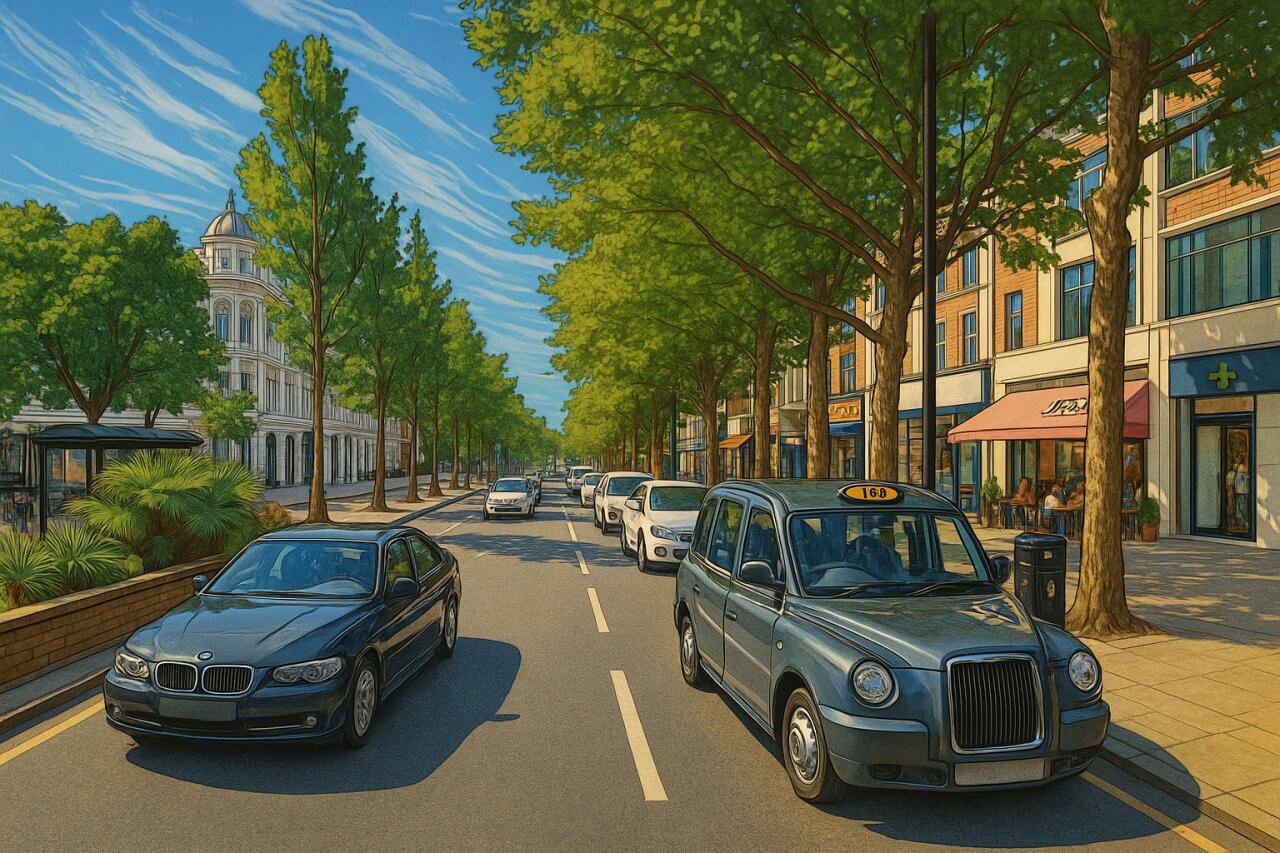
Notting Hill Gate, London
Notting Hill Gate is a prominent thoroughfare in the Royal Borough of Kensington and Chelsea, connecting Holland Park Avenue in the west to Bayswater Road in the east. Positioned in the heart of West London, it acts as a gateway to the iconic Notting Hill district and serves as a vibrant commercial and cultural corridor in its own right.
Overview and Layout
Notting Hill Gate is approximately 632 metres (2073 feet) long, running in an east-west direction. It forms part of the major A402 route and carries two-way traffic, with several lanes accommodating a mix of cars, buses, and bicycles. The street is known for its steady vehicular flow and active pedestrian environment, especially around the central intersection by Notting Hill Gate Underground Station.
Roads connected to Notting Hill Gate
- Bayswater Road
- Campden Hill Road
- Clanricarde Gardens
- Hillgate Street
- Holland Park Avenue
- Kensington Church Street
- Kensington Palace Gardens
- Kensington Mall
- Linden Gardens
- Orme Square
- Pembridge Gardens
- Pembridge Road
History and Origins
The name Notting Hill Gate originates from a historic toll gate that once stood in the area during the 18th century. The "Gate" referred to an actual turnpike gate installed to collect tolls from travelers using the road into central London. The surrounding area, known as Notting Hill, is believed to derive from the Anglo-Saxon name "Knottinghill", meaning a hill belonging to a Saxon individual or family.
The pronunciation is commonly rendered as ‘Not-ing Hill Gate’, phonetically noted in the International Phonetic Alphabet as /ˈnɒtɪŋ hɪl ɡeɪt/. The toll gate was removed in the mid-19th century, but the name remains to this day, marking the transition of the area from rural outskirts to a developed urban district.
The toll gate was removed in the mid-19th century, but the name remains to this day, marking the transition of the area from rural outskirts to a developed urban district.
Character and Atmosphere
Today, Notting Hill Gate is a lively and cosmopolitan street. It features a mix of Victorian and post-war architecture, local shops, supermarkets, cafés, and banks, interspersed with quirky independent outlets and classic London pubs. The character of the road reflects its surrounding area — bohemian, multicultural, and somewhat upmarket — but less picturesque than the leafy side streets of Notting Hill itself. Office blocks and apartment buildings blend with small boutiques, making the area highly functional for both residents and commuters.
Sights and Attractions Nearby
While Notting Hill Gate itself is primarily a transportation and shopping corridor, it is a short walk from some of London's most loved destinations:
- Portobello Road Market – A world-famous street market offering antiques, food, and vintage goods, located just north of Notting Hill Gate.
- Kensington Palace and Gardens – Found southeast of the road, this royal residence and its expansive parkland are easily accessible by foot.
- Gate Theatre – A small but renowned independent theatre located above the Prince Albert pub, known for avant-garde performances.
- Coronet Theatre – A historic venue turned modern arts centre that hosts live music, dance, and film screenings.
Property and Real Estate
Notting Hill Gate is situated in one of London’s most desirable and expensive residential areas. As of May 2025, average property prices in the vicinity are around £1,350 per square foot (approx. £14,500 per sq metre), though prices can vary significantly by property type and location.
- A one-bedroom flat (approx. 550 sq ft / 51 sq m) may cost in the region of £740,000.
- Larger two- or three-bedroom apartments (1,000–1,500 sq ft / 93–139 sq m) often range between £1.3 million to £2.2 million.
These prices are considerably higher than the London average, reflecting the area’s prime location, historic appeal, and access to green spaces.
Transport and Connectivity
London Underground
Notting Hill Gate Station sits at the centre of the street and is served by three Underground lines:
- Central Line – Offers east-west service through central London, including stops at Oxford Circus and Liverpool Street.
- Circle Line – Loops around central London, useful for destinations like South Kensington, Westminster, and King’s Cross.
- District Line – Serves destinations from Wimbledon and Richmond to the east of London, via Victoria and Embankment.
Buses
Multiple bus routes serve the area, with stops along Notting Hill Gate itself and adjacent roads. Key routes include:
- Route 27 – Camden Town to Hammersmith
- Route 28 – Kensal Rise to Wandsworth
- Route 52 – Willesden to Victoria
- Route 70 – South Kensington to Acton
Most bus stops have live departure screens and shelter seating, and they’re spaced no more than a few minutes’ walk from any point on the street.
Fun Fact
The Notting Hill Gate Tube Station underwent a significant refurbishment in 2011 that uncovered a hidden 1950s-era passageway featuring advertisements that had been sealed off for decades. The vintage posters, still intact, include promotions for holidays, cigarettes, and West End shows, offering a time capsule of mid-20th century London life.
Quick Facts
- Location: Royal Borough of Kensington and Chelsea, West London
- Length: Approx. 0.5 miles (0.8 km)
- Direction: Runs east–west from Holland Park Avenue to Bayswater Road
- Name Origin: Named after a toll gate formerly at this location; "Notting Hill Gate" pronounced /ˈnɒtɪŋ hɪl ɡeɪt/
- Main Attractions Nearby: Portobello Road Market, Kensington Gardens, Gate Theatre, Coronet Theatre
- Property Prices (May 2025): Around £1,350 per sq ft (£14,500 per sq m)
- Underground Station: Notting Hill Gate (Central, Circle, District Lines)
- Nearby Bus Routes: 27, 28, 52, 70 and more
- Character: Lively, commercial, functional with historic charm
- Fun Fact: 1950s posters discovered in sealed Underground passageway during 2011 renovation
Map of Notting Hill Gate, London

Painting of Notting Hill Gate, London (View image in full size)